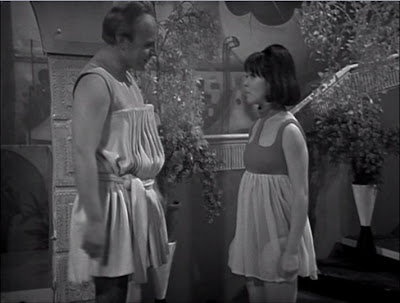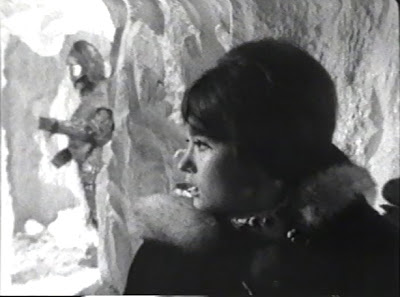 |
Episode 1, 10 August 1968
Episode 2, 17 August 1968
Episode 3, 24 August 1968
Episode 4, 31 August 1968
Episode 5, 7 September 1968
Written by Norman Ashby
Directed by Morris Barry
Script editor: Derrick Sherwin
Producer Peter Bryant
Patrick Troughton as the Doctor
Frazer Hines as Jamie McCrimmon
Wendy Padbury as Zoe Heriot (earliest extant appearance)
On the planet Dulcis, war and strife are unknown. Also unknown is basic scientific curiosity--172 years ago, Dulcian scientists detonated an atomic bomb on an isolated island, so that they could study how long it took for radiation levels to subside. But when all the radiation levels suddenly drop to zero, the Dulcians don't respond with, "Holy crap, that must mean the advance force from a race of merciless alien invaders must have landed on the island and used that radiation for fuel as they prepare to destroy our planet!" or even the perhaps more reasonable, "Hmm, that's weird. Maybe we should head over to the island and try to figure out why the radiation suddenly vanished." No, instead they say, "Well, now we know--radiation from an atomic blast lasts 172 years, then vanishes completely."
But I'm getting ahead of myself. The formerly-radioactive island. Four groups have arrived there at roughly the same time: a trio from a Dulcian university, studying radiation; a party of adolescent adventurers, visiting the island without passes as a way to spice up prosperous-yet-monotonous life on Dulcis; the TARDIS team; and a spaceship carrying two Dominators.
The Dominators are a race of merciless alien conquerors, "rulers of the Ten Galaxies". Their spaceships are powered by radiation, but this particular ship is almost out of power. Detecting the radioactive island, they've come to Dulcis, where they immediately suck up all the radiation to refuel. But this replenishes their power levels only enough to give them the energy for a full refuel, which involves drilling to the molten core of Dulcis and dropping an atomic bomb down the shaft, to irradiate the whole core--which incidentally will also turn all of Dulcis into a radioactive cinder, destroying all life on the surface.
Of course, the TARDIS team and the Dulcians soon discover this. The story's what-makes-this-story-different-from-others quality comes in the difficulty our heroes have in getting the Dulcians to fight back, because of the ethos of nonviolence and incuriosity that permeates society on Dulcis. First, the Dulcians flat out don't believe that aliens have landed on their planet, because they don't believe in aliens. Then, they refuse to accept the threat the Dominators pose, and continue to maintain that if only they treat the invaders with friendliness and obedience, they'll be able to bring out the Dominators' peaceful side. And then when they do finally realise what danger they're in, they don't even know how to fight back.
(This is illustrated very well in a meeting of the High Council of Dulcis: "The way I see it, there are only three courses of action: fight, flight or submission."
"Flight is out of the question!"
"And we have means with which to fight."
"Then that leaves only ... submission.")
Eventually, the Doctor and a small group of Dulcians are able to foil the Dominators' plan by tunneling beneath the radioactive island so that they gain access to the Dominators' drill-bore from the side. This way, when the invaders drop their atomic bomb down the shaft, the Doctor catches it, then stows it aboard the Dominators' spaceship. The spaceship lifts off so that the Dominators can get away from the planet before it explodes, but of course, the only thing they end up destroying is their own ship.
But none of all that is really what sticks with me about "The Dominators". The most memorable thing about this story is that it's our first chance to get a look at the Doctor's new companion, Zoe, the girl genius from the year 2000. (In 1968 terms, "from the year 2000" means "lives in a space station".)
Zoe is a chipper, undeterable character, utterly guileless, completely selfless, friendly, and entirely comfortable with the fact that she's a scientific and mathematical genius. And actress Wendy Padbury is one of the most adorably sexy women ever to make it onto a television screen.
That sexiness and the mores of 1968 combine to ensure that, over the course of her one season on the TARDIS, Zoe is clad a succession of wonderfully enticing costumes, and the one in "The Dominators" is one of the best. The people of Dulcis all walk about in short gowns. For men, this means dresses of a curtain-like material that come down to mid-thigh (longer for figures of authority). But for women, it means a choker and a revealingly short babydoll negligee, easily transparent enough to show off the bikini bottoms being worn underneath. It's glorious.
What Lisa thought
She enjoyed it fine. She did complain about the broad strokes with which the story was told--the utterly good Dulcians contrasted with the utterly ruthless Dominators; the simplicity of, "Well, we'll just burrow in from the side and catch the bomb when they drop it."
This sort of block-colour approach to storytelling even extends to interpersonal dynamics. The two Dominators have a running conflict throughout the story: the first officer wants to destroy everything in sight, murdering any Dulcians he sees, while his commander insists that the natives pose no threat, and they should be spared as killing them will dangerously deplete the spaceships' already dangerously-low levels of power.
In fact, all four cliffhangers in this story involve the first officer ordering the Quarks (diminutive robots that the Dominators use as both a labour force and their footsoldiers) to kill a character, which is then resolved by the commander appearing out of nowhere and countermanding the order. The cliffhangers at the end of part two and part three are in fact identical, with the first officer deciding to destroy a house standing on an opposite hill just to have some fun, unaware that some of our main characters are hiding in the house, and the image fades out as debris falls around our heroes from the blasts of the Quarks' molecular cannon.
(It's interesting that we're supposed to see the first officer as a bloodthirsty fool, while the commander is the voice of intelligence and reason, considering that in the end, it's the first officer who was right the whole time--the natives do pose a threat, and the Dominators' best course of action would have been to slaughter them.)
There is a wonderful example of the comic chemistry between Frazer Hines and Patrick Troughton, when the Dominators (thinking they have captured native Dulcians) subject the two of them to intelligence tests, to evaluate the native populations. The Doctor and Jamie quickly conclude that they should do their best to appear stupid, so as to present less of a threat.
The same scene also illustrates Troughton's nimbleness as an actor, when he convinces the Dominators that there are two species on Dulcis: the stupid ones, represented by him and Jamie, and the smart ones. "There aren't very many of them left. We don't like them very much--they tell us what to do, you see," he says, and all of a sudden his demeanor has changed completely, and with it, the whole tone of the scene. It's not that he's suddenly become threatening, because he hasn't--but with those two sentences and his sudden change in tone, he's managed to summon forth an entire picture in the viewer's mind, and one that's much, much darker than any actual images that appear onscreen in "The Dominators".
But essentially, "The Dominators" is a story where Doctor Who definitely comes across more as a children's programme than a family programme.
But whatever. Zoe, man. In a see-through microdress.
The next story in the rewatch is "The Mind Robber".
